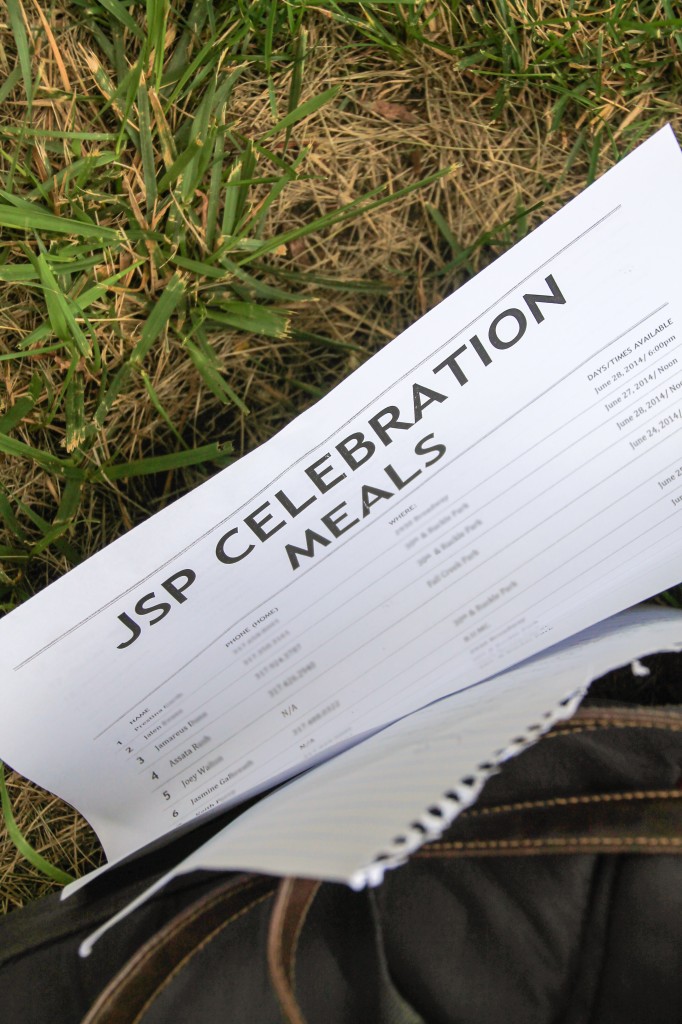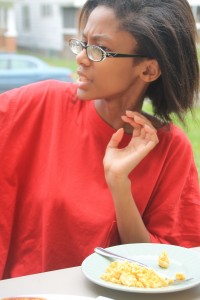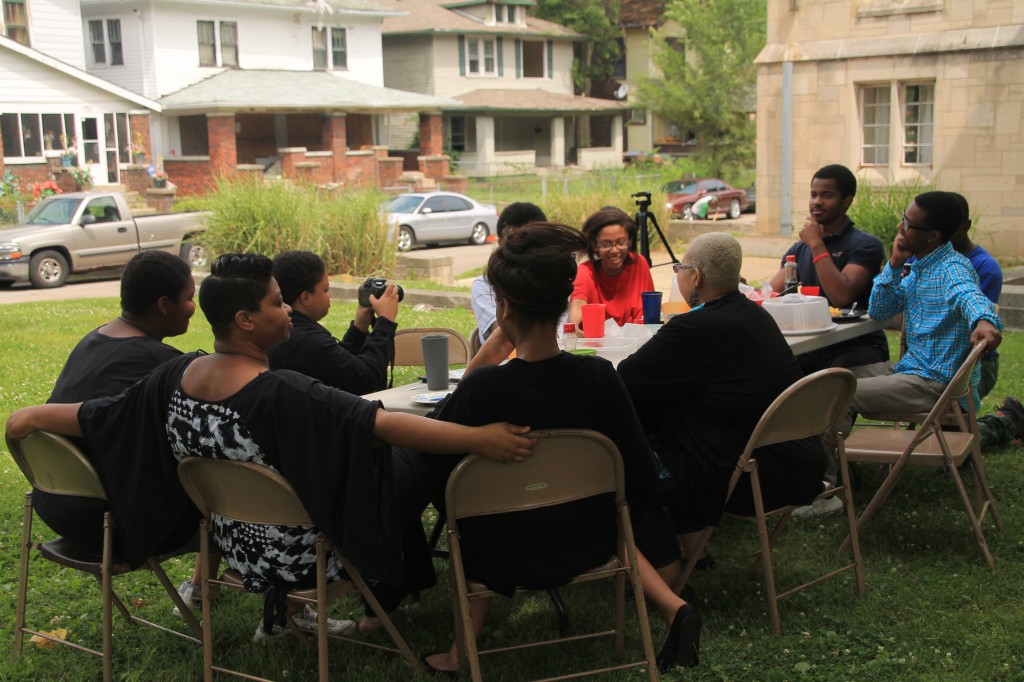
What’s in a meal?
Well, there’s the obvious: Food… togetherness (potentially)… conversation. What else?
A recent meal I had the fortune to attend gave me a glimpse into that answer.
On a warm summer day about a month ago here in Indy, I excitedly followed Broadway United Methodist Church‘s Roving Youth Corps members Joey Walton, Shane Evans and Charita Roberts through the winding, mazelike hallways of this gothic giant onto the brightly lit lawn where a table sat. Bordering the lawn on one side was a row of houses–earthen colored, beautifully old structures with healthy front porches that populate most of Broadway’s diverse neighborhood known as Mapleton Fall Creek.
Roving Youth Corps (RYC) is a cadre of paid community organizers, ages 13-19 from the Mapleton Fall Creek neighborhood, who spend the summer discovering, connecting, and celebrating their neighbors’ gifts, skills, passions and contributions. (See previous blog for more info.)
This year, RYC added an element: a meal would be held around each and every Roving Youth to celebrate them and explore ways that family, friends, and neighbors present could support them in developing their gifts and dreams.
The occasion: one of the 15 or so “Meals” being organized this summer around each and every Roving Youth member. My excitement sprang from my own enduring obsession with this unique style of using meals and the celebration of individuals’ gifts as a strategy for building community, economy and mutual delight which Broadway employs in all kinds of settings… but which I have actually never witnessed in person. I was also curious, having participated as staff of the Roving Youth project last year, how incorporating these meals would change the dynamics of the project as I’d already witnessed it.
One of the things I love most about Broadway is their commitment to regularly and rigorously examine–and, if needed, completely revamp–what they do and how they do it for the sake of living in line with their beliefs around looking for and investing in abundance over scarcity and living together in authentic community with one another and their neighbors. This addition to the RYC project struck me as a sign that this commitment to growth and adaptation lives on at Broadway.
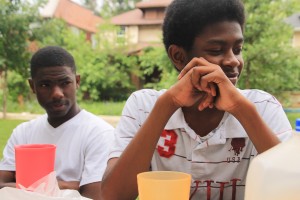
Akil (R)
Today’s lunch would focus on a family that lived in the house right across the street and which now had three of its youth working as Roving Youth.
There’s Akil, a lanky, cheerful young man of about 15 years…
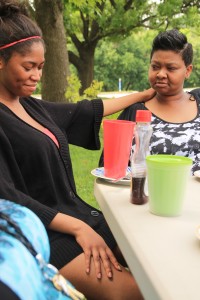
Nyderia (L) and her mother, Connie
Nyderia, an introspective,
intense young woman with insane artistic vision and skill, (both of whom I worked with last year in RYC)…
…and Assata, youngest of the three present, birdlike-thin, with an extreme shyness equally matched with her gift with words and sprinkling arrestingly deep insights into everyday conversation. A first-time Rover, Assata impressed us all this year when she said in her interview, “To be honest, I think I want to prove myself to my Mom because she usually thinks that I’m lazy and I usually just bail out on most things like doing stuff outside since I usually stay inside the house. I want to see if she’s right or wrong by proving myself by doing this job.”
Before recounting the meal itself, I’d like to explore for a minute why this idea of “meals” is so worth writing about, and my own story of discovery with them.
Breaking Bread = An Overlooked Engine for Change
It was De’Amon Harges, Broadway’s first Roving Listener, who first introduced me to the idea of “meals” as a potent tool for transformation and democracy-building — for generating community, economy, and mutual delight.
At that time, I was in charge of an asset-based Neighborhoods Initiative at a nonprofit called SCOPE in Sarasota, FL (my home state). Fresh out of college, but already experienced in a variety of group processes via my hankering for immersing myself in political, labor and intentional community organizing efforts, I had been exposed through SCOPE to even more methods for sparking both big-picture social change and healthy relating, decision-making and living in individuals, groups and organizations.
I had found myself intrigued but unsatisfied with the approaches I had encountered so far–from your usual Robert’s Rules of Order and agenda-based meeting (used by most organizations and by many neighborhood associations) to more nontraditional styles like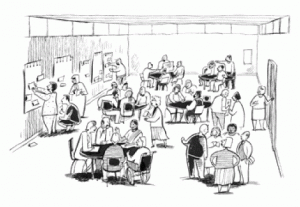 Peter Block’s Small Group conversations, Open Space, World Cafe and others. I had seen, and oftentimes helped design and host, many such gatherings… and while some were effective in certain contexts, definitely valuable, and resonated with my own inside-out philosophy, I still sensed something missing–especially in the context of neighborhoods and community.
Peter Block’s Small Group conversations, Open Space, World Cafe and others. I had seen, and oftentimes helped design and host, many such gatherings… and while some were effective in certain contexts, definitely valuable, and resonated with my own inside-out philosophy, I still sensed something missing–especially in the context of neighborhoods and community.
I noticed that most often, people coming from both neighborhoods and organizations who wanted to “engage” citizens in neighborhoods would hold meetings. Yet, the people seemed to always attend only represented a small segment of the community–usually older residents, or those with a specific personal or organizational agenda. I rarely saw young people, parents, or people who generally weren’t used to their voice being heard in these meetings.
What’s more, meetings always felt like work. If I weren’t paid to attend those meetings, I could hardly see myself choosing to go as just a resident or neighbor. In my own organizing work, I also felt unsatisfied with methods such as Block’s Small Group conversations, World Cafe or even Open Space. Each are fascinating, powerful practices (which I highly recommend checking out), but didn’t quite hit home.
When De’Amon first explained meals as an organizing tool during one of our long walking talks through the streets of Chicago (my first time meeting him)–something clicked. He told me how, after roving Mapleton Fall Creek and discovering patterns of people with common passions or skills (Gardeners, Artists, Entrepreneurs), he would bring them together for a simple meal–no agenda or facilitation beyond his revelation at the beginning of the commonality he had noticed. From these meals, people found their own energy for connecting, built relationships naturally, and more often than not, decided on their own to continue getting together or embark on a small project together.
“How genius!” I thought instantly. After all, savvy business-people and politicians have long known the power of conversation and food for advancing their work. They recognize that breaking bread in an informal setting helps generate the kind of relaxed mutual delight, sense of freedom, and organic emergence of ideas, and opportunity for interesting dialogue that lead to trust–which are the foundation of doing good business or pretty much anything that will last a long while.
In contrast, the kinds of meetings and designs I’d seen used (and used myself) to try and connect people around specific issues, concerns or possibilities more often than not ended up with a lot of frustrated expectations, distorted ideas about who was responsible for what, unproductive confrontation and very little sense of real fellowship, relationship, relaxation or fun. And, so much of what was talked about, from the most basic small project steps to big grandiose visions, never actually happened when people went home.
De’Amon and others at and around Broadway had been bringing people together not just to eat and converse, but with an understanding of how a simple meal can create beautiful, unexpected results by virtue of its relaxed, personal and very practical nature. After all, “We all gotta eat”–and, inviting someone to share food with you has a very different feeling than inviting them to a meeting… right?
And, such a gathering has a very special power to achieve what even the most tightly-planned and strategically plotted traditional meeting cannot: the power to reveal organically, naturally, where there is energy within each person and within the group. Sometimes, the result is a collaboration or a series of collaborations. Sometimes, it’s a story that sticks and subtly, powerfully influences one or more of us as we go back to our daily lives.
Finally, I love meals because they are something that literally anyone can do. They can be done almost anywhere and with any kind of food. Like so many practices within Asset-Based Community Development, they are something which seems so commonplace yet has an incredible, but forgotten, power to spur innovation, community, economy, and all those good things we keep trying to invent new and shiny technologies to achieve.
This universality and time-work relevance aren’t just feel-good things–they also make this strategy relevant in terms of social justice, since more often than not (as I witnessed keenly in Sarasota), meals have a magical way of equalizing unbalanced power relations. They are not nearly as intimidating as old-school meetings or as to people used to being excluded from mainstream society, decision-making or traditional rings of power as a meeting can often be. With a jovial air, they suggest–and, I’d argue, help to create–equality and friendship.
This was the air, spiced with a tinge of anxious, expectant mystery, that hung about the table that summer around noon as I joined the table with old friends, potential new friends, and fellow social experimenters…
Go to Part II

